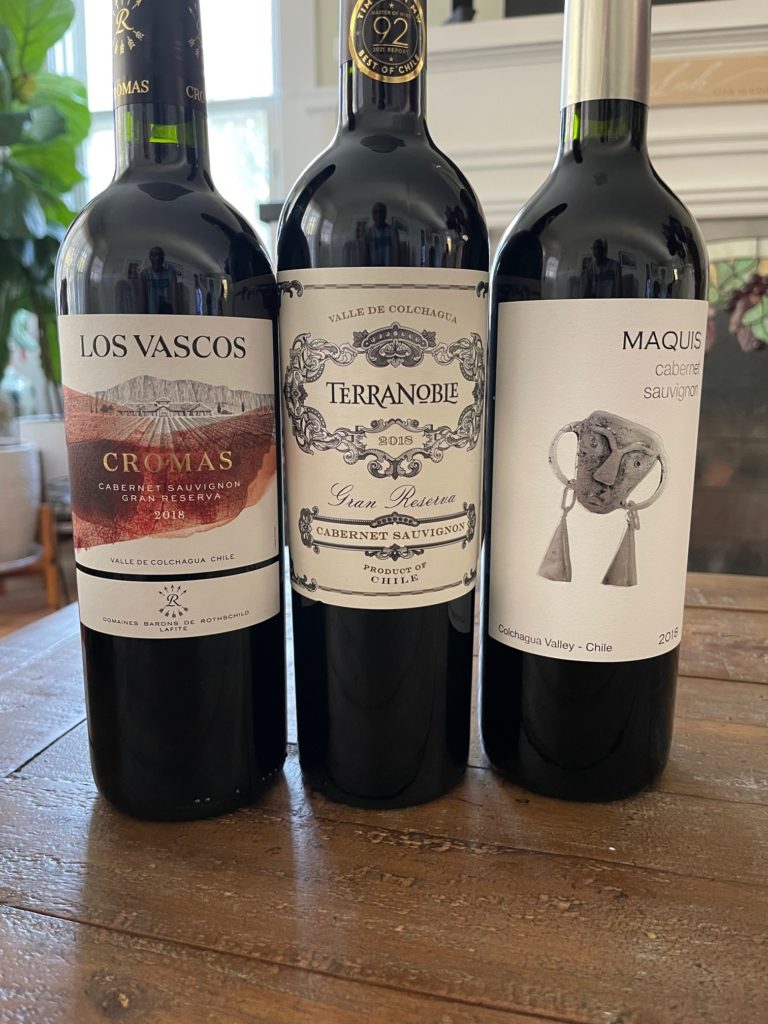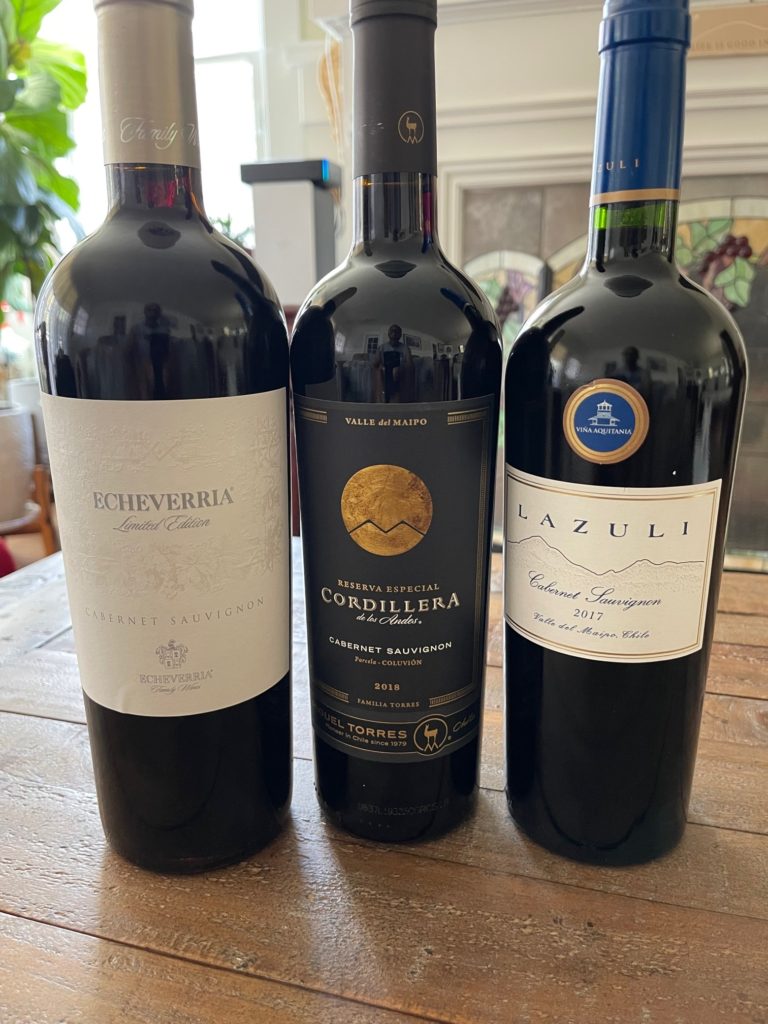Cabernet Sauvignon is both the most widely planted red variety in Chile and the grape credited with putting Chile on the world stage. While it accounts for just over 20% of all vineyard plantings in Chile, the lion’s share of Cabernet is grown in the Central Valley.
Within the Central Valley wine region, which spans the area west of the Andes to the Pacific Coast. The sheltering presence of the Coastal mountain range makes the Central Valley relatively warm and dry.
It is one of Chile’s largest wine regions, and there you will find a wide variety of wine styles and quality from many different terroirs.
This article explores the stylistic differences between Cabernet Sauvignon from Maipo and Colchagua, two regions identified with some of Chile’s best Cabs (as seen in the maps below).


Disclosure: The following wines were provided as media samples for review. All reviews, descriptions, and opinions are my own. No other compensation was involved.
Colchagua Valley
About two-thirds of the Cabernet Sauvignon planted in Chile is planted in the Colchagua Valley. It boasts a classic wine-growing climate – warm, but cooled by Pacific Ocean breezes. It’s a bit cooler than its northerly cousin Maipo, but still maintains a consistently Mediterranean climate.
Colchagua is also separated in to the Alto Colchagua and Colchagua regions.
Like Maipo (in particular Alto Maipo) the Alto Colchagua features steep slopes on the eastern edges of the Andes Mountains, where the higher vineyards can take advantage of free-draining soils and a wide diurnal swing which offers an extended growing season yielding smaller grapes with a higher concentration of flavors combine with balanced ripeness and acidity.

Tasting Notes
- 2018 Barons de Rothschild (Lafite) Cabernet Sauvignon Los Vascos Cromas Gran Reserva – Chile, Rapel Valley, Colchagua Valley
Medium ruby color with alluring cassis, tobacco, cedar, cacao, vanilla and baking spice aromas. On the palate it’s medium-bodied, with medium acidity, and well integrated fine-grained tannins with flavors of cassis, fig paste, plum, vanilla and baking spice with a long finish. Blend of 85% Cabernet Sauvignon, 10% Syrah and 5% Carménère from the Peralillo DO. This winery is a joint venture between Santa Rita and the Rothschilds of Bordeaux. 14.5% abv|SRP – $22 (91 pts.) - 2018 TerraNoble Cabernet Sauvignon Gran Reserva – Chile, Rapel Valley, Colchagua Valley
Ruby color with inviting cassis, black cherry cigar box, dark roast espresso, and dried herb and pencil shavings. On the palate, it’s medium-bodied with medium plus acidity and velvety tannins with cassis, black cherry, espresso, and vanilla flavors with a hint of graphite. Medium finish. 100% Cabernet Sauvignon 70% from the Los Lingues DO in the Colchagua Andes, and 30% from the
Marchigüe DO, between the ranges 14% abv|SRP – $20 (89 pts.) - 2018 Viña Maquis Cabernet Sauvignon – Chile, Rapel Valley, Colchagua Valley
Ruby color with subtle blackberry, black cherry, dried herb, bell pepper, cedar, vanilla, and a hint of violet aromas. On the palate, it’s medium-bodied with medium-acidity and velvety tannins with blackberry, black plum, black cherry, and vanilla flavors. Medium finish. Blend of A 90% Cabernet Sauvignon, 6% Cabernet Franc, 3% Carmenere and 1% Petit Verdot. 14% abv|SRP – $20 (87 pts.)
Maipo Valley
The Maipo Valley (a.k.a. ‘Bordeaux of South America’) is located south of the capital of Santiago. It is the historic core of vineyards in Chile, and there, you will find some of the country’s oldest and best-known vineyards. Its terroir formed by the eponymous river. The Maipo river begins at the volcano (also named Maipo) and along with its tributaries has created an intricate network of valleys around Santiago de Chile at a height of 762 m (2,500 feet) above sea level, resulting in four alluvial terraces that define the region’s soils. The region can be roughly separated into three broad areas: Alto Maipo, Central Maipo and Maipo Bajo.
The best vineyards are in the Alto (upper) Maipo and quality goes downhill (literally) as the temperature increases with decreases in elevation, making Maipo Bajo, the warmest sub-region in Maipo.

Tasting Notes
- 2016 Echeverría Cabernet Sauvignon Limited Edition – Chile, Central Valley
- Just translucent garnet color with dark red fruit, dark chocolate, cedar, vanilla, leather and subtle pyrazine aromas. On the palate, it’s medium-full bodied with very good acidity and supple tannins with black cherry, plum, red currant and spice flavors with a medium+ finish. Blend of 85% Cabernet Sauvignon, 10% Syrah and 5% Carménère. 14% abv|SRP – $25 (88 pts.)
- 2018 Miguel Torres Cabernet Sauvignon Cordillera Reserva Especial – Chile, Maipo Valley
- Just translucent garnet color with red fruit, violets, cacao, espresso, dried herbs and cedar aromas. On the palate, it’s medium-bodied with vibrant acidity and supple tannin with red currant, black cherry, and vanilla spice flavors with a very generous finish. 100% Cabernet Sauvignon planted at 2,600 feet at the edge of the Pirque DO.14% abv|SPR – $20 (90 pts.)
- 2017 Viña Aquitania Cabernet Sauvignon Lazuli – Chile, Maipo Valley
- Translucent garnet color with appealing red currant, plum, violet, cigar box and a hint of bell pepper aromas. On the palate, it’s medium-bodied with a wonderful mouthfeel very good acidity and supple tannins, with red currant, black cherry, plum vanilla, dark chocolate, and spice flavors nicely accented with savory notes and a very generous finish. 100% Cabernet Sauvignon planted at 2,300 feet. 14.5% abv| SRP – $45 (90 pts.)
Generally speaking, I found the Maipo wines were garnet colored, while the Colchagua Cabs were ruby colored.
To my palate, the Maipo Cabs tended to be more red and black fruited and supple tannins, while the Colchagua Cabs were more red-fruited with firmer velvety tannins.
My Takeaways
This was a fun and informative juxtaposition of Cabernet Sauvignon from Maipo and the Colchagua. I have two key takeaways. First, both regions produce high quality Cabs that are comparable to some of the best Cabs wines in the world at a fraction of the price. If that, in and of itself weren’t laudable enough, the wines I sampled were pretty diverse. All were labeled Cabernet Sauvignon, and half of the six wines were 100% Cab. The other half offer a diverse blend of both Bordeaux and non-Bordeaux grape varieties. I tend to prefer Bordeaux blends rather than 100% Cabernet Sauvignon, but that just means there’s something for all Cabernet Sauvignon loves in Chile!
Also, I invite you to learn more Chile’s long standing commitment to sustainablity.
Many thanks to Creative Palate and Wines of Chile for providing the samples and background information!
With Carmenere so often being associated with Chile, we were surprised a few years back to know Cab was their most widely planted variety. We had some terrific ones down there but none of the ones in your article…we’re now on the hunt up here!
This was a wonderful bunch of Cabs that reinforced the tremendous QPR of Chilean wines for me.